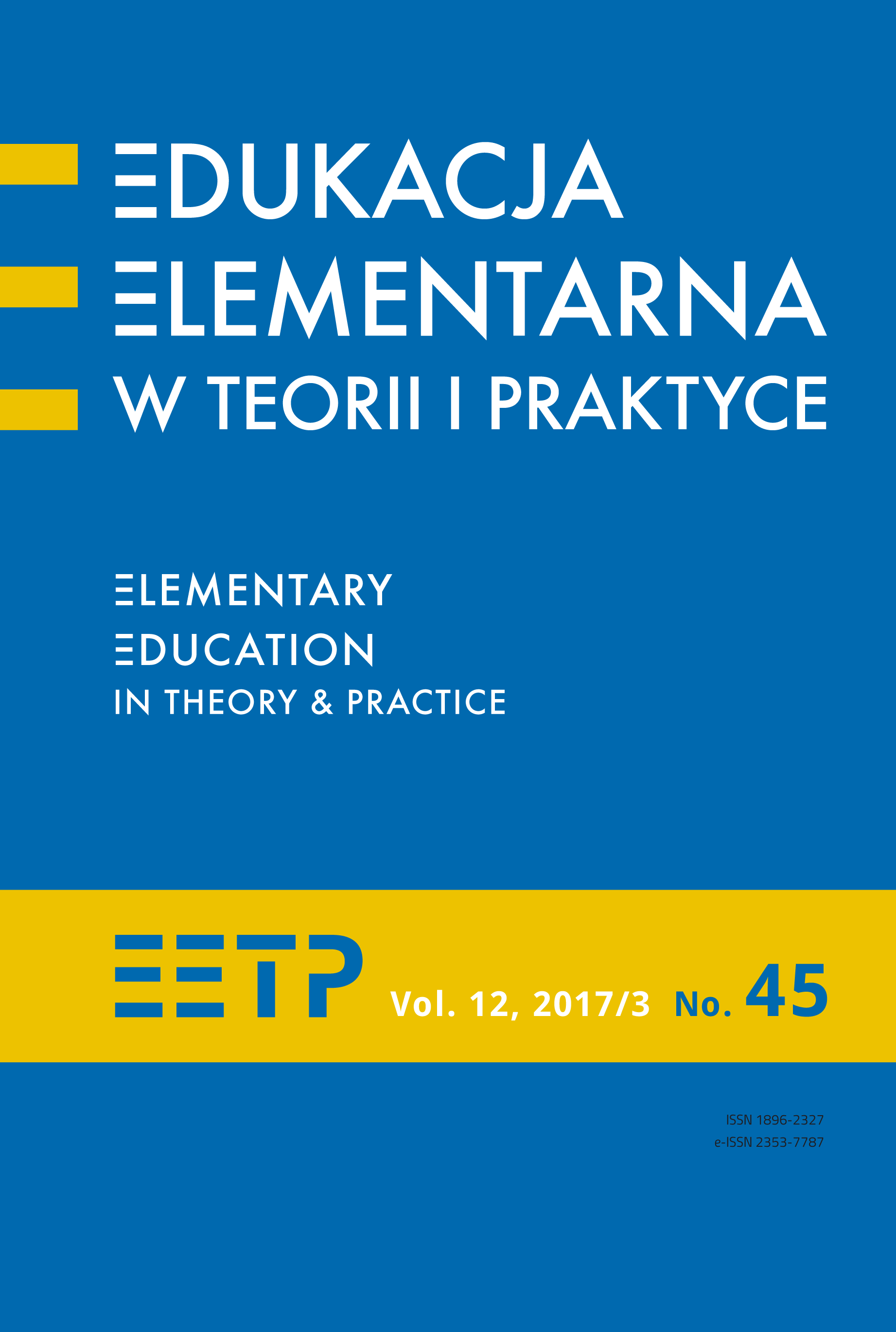Lektura młodszych dzieci w kulturze audiowizualnej
Abstrakt
Kultura audiowizualna wywołała i określiła nowe postawy odbiorcze, tworząc tym samym inne niż parę lat temu możliwości i potrzeby współczesnego dziecka w wieku wczesnoszkolnym. Jeśli przyjąć, że wychowywany w takiej rzeczywistości uczeń operuje kodem nowych mediów, w tym telewizji, a jego postrzeganie świata opiera się na percepcji audiowizualnej, to proces organizacji kształcenia literackiego na pierwszym etapie edukacyjnym powinien być szczególnie starannie przemyślany. Chodzi bowiem o dobór takich tekstów, które nie tylko prezentują sztukę słowa, ale także odpowiadają na zredefiniowaną sytuację antropologiczną. W takie założenia wpisują się teksty literatury audiowizualnej kierowanej do młodszych czytelników, które w wyniku przekraczania horyzontów zarezerwowanych dla jednego gatunku artystycznego harmonizują z naturalnymi aktualnymi dziecięcymi zdolnościami i wymaganiami. Jednocześnie motywują do literackiej praktyki, umożliwiając rozwój kompetencji czytelniczych i umiejętności rozpoznawania świata. Praca jest próbą wyjaśnienia funkcji literatury audiowizualnej w oswajaniu najmłodszych uczniów z lekturą w przedstawionym kontekście i egzemplifikacji. Na podstawie rekonstrukcji aktualnej sytuacji kulturowej dzieci w młodszym wieku szkolnym postawiona została teza o konieczności takiego wychowania ich do lektury, które obejmuje teksty literackie wykorzystujące doświadczenia i dorobek nowych mediów, łącząc się z nimi, nie tracąc jednocześnie artystycznych walorów. Przedstawione przykłady i wnioski mają stanowić konstruktywną odpowiedź na rejestrowany stan rzeczy.
Bibliografia
Antonik D., Autor jako marka. Literatura w kulturze audiowizualnej społeczeństwa informacyjnego, TAiWPN Universitas, Kraków 2014.
Chyła W., Kultura audiowizualna, Wydawnictwo Fundacji Humaniora, Poznań 1999.
Escarpit R., Literatura i społeczeństwo, tłum. J. Lalewicz, [w:] Współczesna teoria badań literackich za granicą, red. H. Markiewicz, Wydawnictwo Literackie, t. 3, Kraków 1973.
Hopfinger M., Doświadczenia audiowizualne: o mediach w kulturze współczesnej, wyd. „Sic!”, Warszawa 2003.
Hopfinger M., Literatura w kulturze audiowizualnej, „Pamiętnik Literacki” (1992)83/11.
Juza M., Memy internetowe- tworzenie, rozpowszechnianie, znaczenie społeczne, „Studia Medioznawcze” (2013)4.
Kłakówna Z.A., Język polski. Wykłady z metodyki. Akademicki podręcznik myślenia o zawodzie szkolnego polonisty, Oficyna Wydawnicza „Impuls”, Kraków 2016.
Leszczyński G., Magiczna biblioteka. Zbójeckie księgi młodego wieku, wyd. Centrum Edukacji Bibliotekarskiej, Informacyjnej i Dokumentacyjnej, Warszawa 2007.
Limont W., Analiza wybranych mechanizmów wyobraźni twórczej. Badania eksperymentalne, Uniwersytet Mikołaja Kopernika, Toruń 1996.
Lindstrom M., Dziecko reklamy, Dlaczego nasze dzieci lubią to co lubią, wyd. Świat Ksiażki, Warszawa 2005.
Leeuwen J., Ćwir!, Wydawnictwo Dwie Siostry, Warszawa 2015.
Regiewicz A., O niemożliwości literatury lokalnej. Przypadek narracji audiowizualnej, „Rocznik Komparatystyczny” 6 (2015).
Regiewicz A., Warońska J., Widowiskowość i audiowizualność w dobie ponowoczesności, Wydawnictwo im. Stanisława Podobińskiego Akademii im. Jana Długosza w Częstochowie, Częstochowa 2012.
Rodari G., Interesy Pana Kota, Muchomor, Warszawa 2013.
Szyłak J, Druga strona komiksu, Wydawnictwo PWZS, Elbląg 2011.
Szyłak J., Komiks w kulturze ikonicznej XX wieku, Słowo/obraz terytoria, Gdańsk 1999.
Wordsworth W., Oda: Przeczucia nieśmiertelności pamiętane z wczesnych lat dzieciństwa, [w:] Od Chaucera do Larkina. 400 nieśmiertelnych wierszy, 125 poetów anglojęzycznych z 8 stuleci, wybór, tłum. i red. S. Barańczak, Znak, Kraków 1988.
Zabawa K., Rozpoczęta opowieść. Polska literatura dziecięca po 1989 roku wobec kultury współczesne, Wydawnictwo WAM, Kraków 2013.
Zawojski P., Elektroniczne obrazoświaty. Między sztuką a technologią, Szumacher, Kielce 2000.
Copyright (c) 2017 Edukacja Elementarna w Teorii i Praktyce

Utwór dostępny jest na licencji Creative Commons Uznanie autorstwa – Bez utworów zależnych 4.0 Międzynarodowe.
1. Autor zgłaszając swój artykuł oświadcza, że jest Autorem artykułu (zwanego dalej Utworem) i:
- przysługują mu wyłączne i nieograniczone prawa autorskie do Utworu,
- jest uprawniony/a do rozporządzania prawami autorskimi do Utworu.
Oświadcza, że nie narusza praw autorskich osób trzecich i praw prawnych.
Oświadcza, że nie występuje żaden konflikt interesów.
2. Udziela Uniwersytetowi Ignatianum w Krakowie nieodpłatnej, niewyłącznej, nieograniczonej terytorialnie licencji do korzystania z Utworu na następujących polach eksploatacji:
- utrwalania utworu w formie papierowej, a także na nośniku cyfrowym lub magnetycznym;
- zwielokrotnienia utworu dowolną techniką, bez ograniczenia ilości wydań i liczby egzemplarzy;
- rozpowszechniania utworu i jego zwielokrotnionych egzemplarzy na jakimkolwiek nośniku, w tym wprowadzenia do obrotu, sprzedaży, użyczenia, najmu;
- wprowadzenia utworu do pamięci komputera;
- rozpowszechniania utworu w sieciach informatycznych, w tym w sieci Internet;
- publicznego wykonania, wystawienia, wyświetlenia, odtworzenia oraz nadawania i reemitowania, a także publicznego udostępniania utworu w taki sposób, aby każdy mógł mieć do niego dostęp w miejscu i czasie przez siebie wybranym;
- w zakresie praw zależnych do Utworu, obejmujących w szczególności prawo do dokonania koniecznych zmian w Utworze, wynikających z opracowania redakcyjnego i metodycznego, a także do dokonania tłumaczenia Utworu na języki obce.
Udzielenie licencji następuje z chwilą przekazania Utworu na rzecz Uniwersytetowi Ignatianum w Krakowie. Uniwersytet Ignatianum w Krakowie jest uprawniony do udzielania dalszych sublicencji do Utworu, w zakresie udzielonego prawa. Licencja jest ograniczona czasowo i zostaje udzielona na okres 15 lat, licząc od daty jej udzielenia.
Wyraża się zgodę i zachęca autorów do publikacji ich tekstu w Internecie (np. w repozytorium instytucji lub na jej stronie internetowej) przed lub podczas procesu składania tekstu jako, że może to prowadzić do korzystnych wymian oraz wcześniejszego i większego cytowania opublikowanego tekstu (Patrz The Effect of Open Access). Zalecamy wykorzystanie dowolnego portalu stowarzyszeń badawczych z niżej wymienionych:




